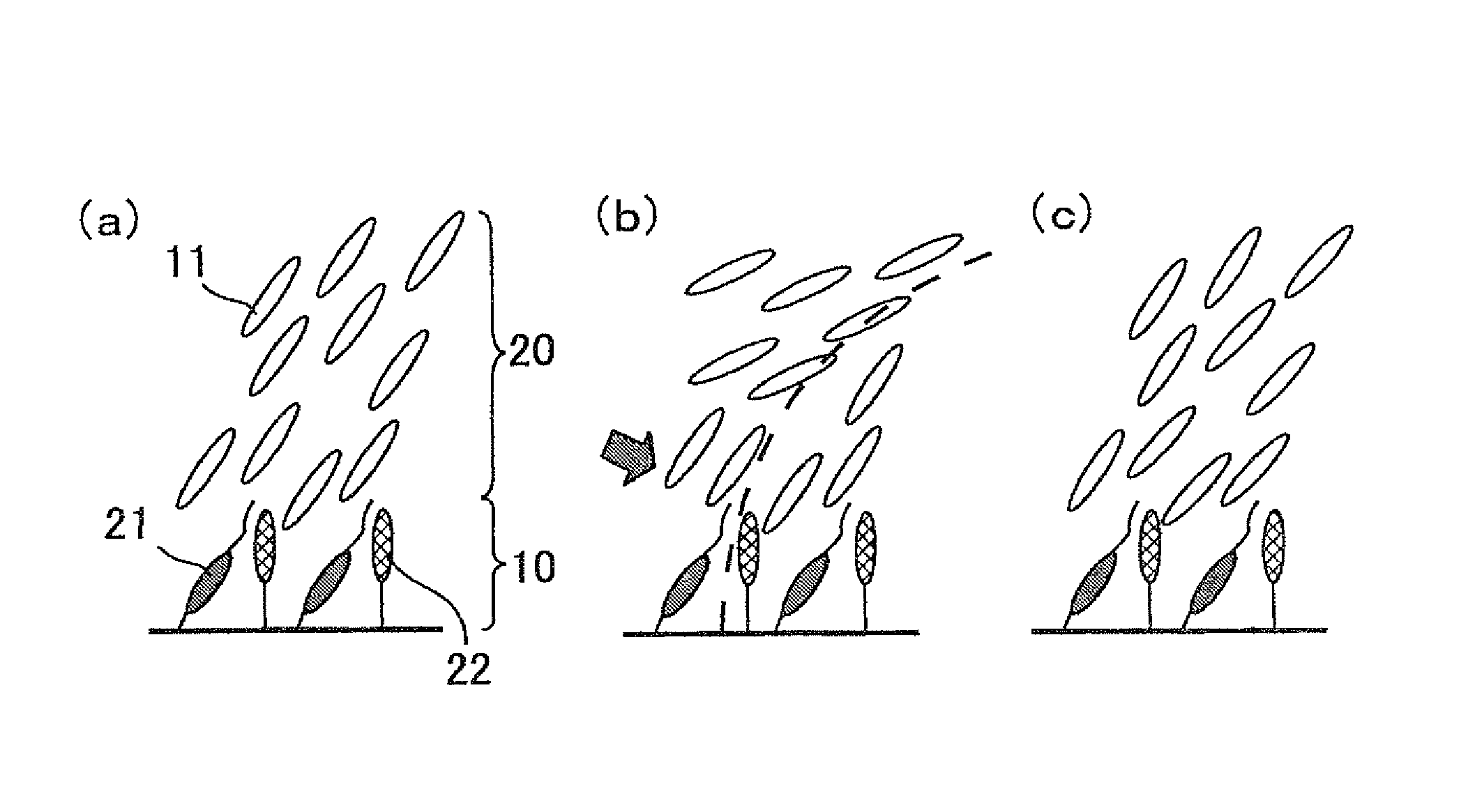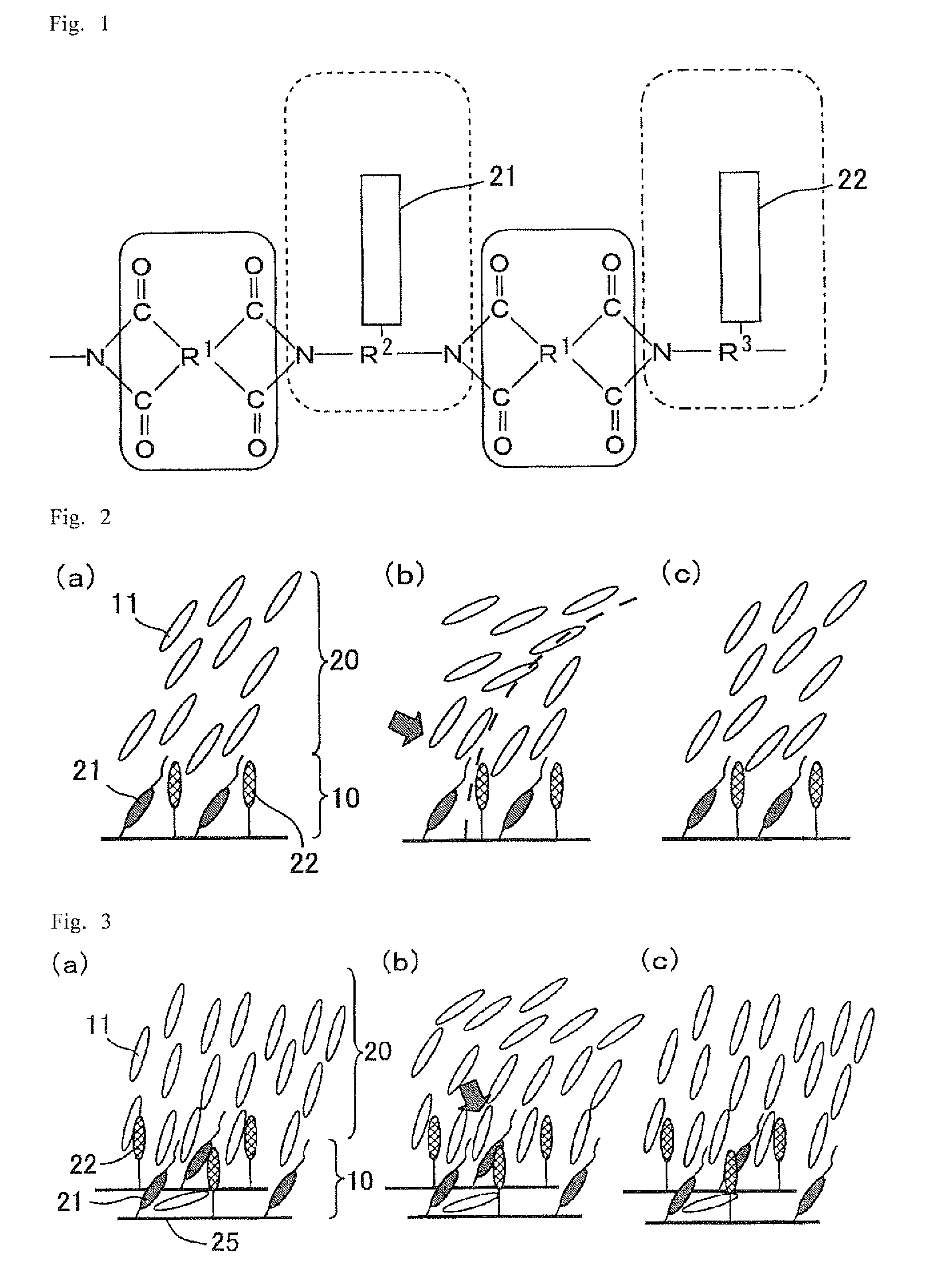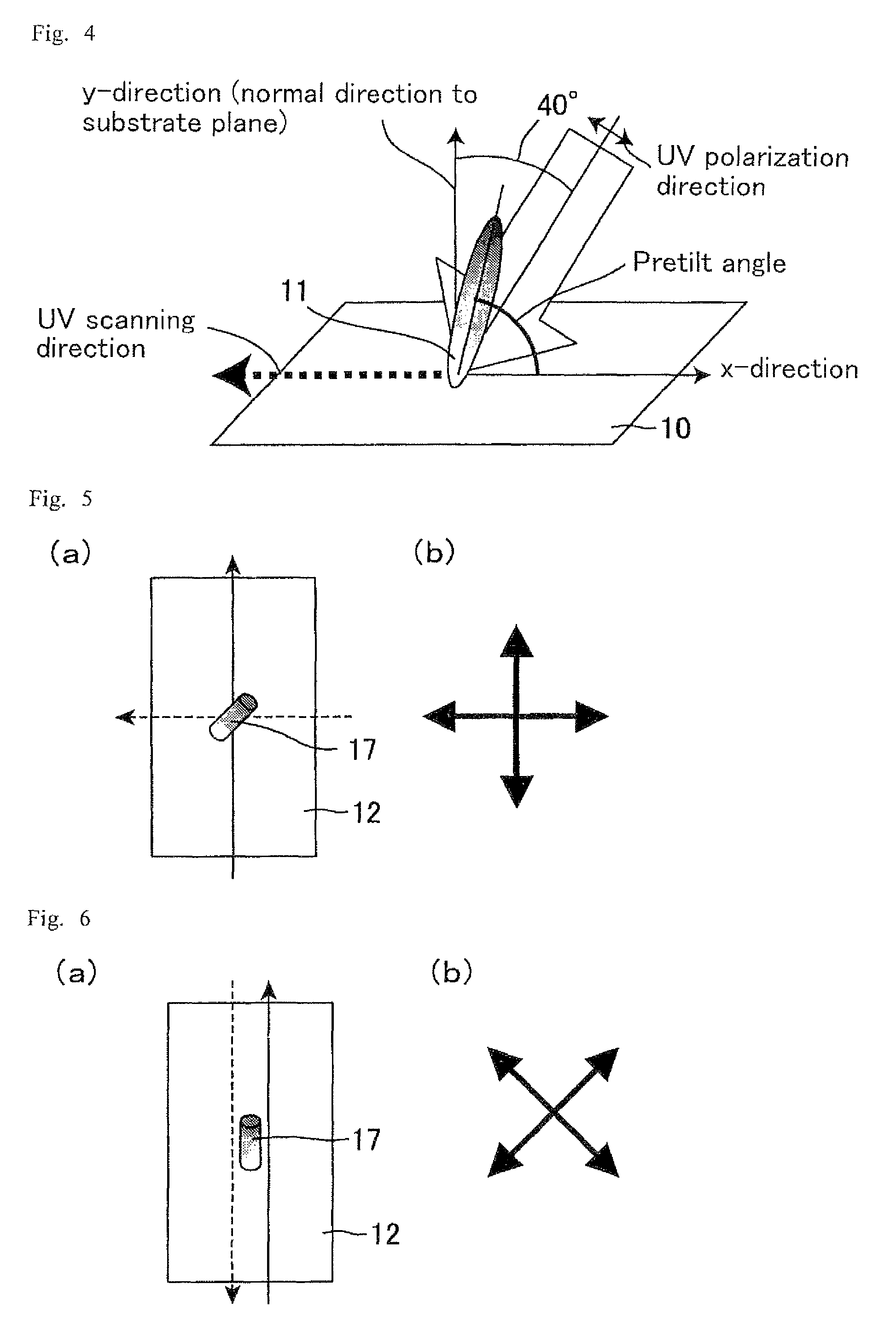[0107]According to the liquid crystal display device and the polymer for alignment film materials of the present invention, generation of the AC image sticking can be suppressed.BEST MODES FOR CARRYING OUT THE INVENTION
[0108]The present invention is mentioned in more detail below with reference to Embodiments using drawings, but not limited to only these Embodiments. In the present Embodiment, a VATN liquid crystal display device is mentioned in detail, but the present invention can be applied to horizontal alignment TN, IPS, and ECB devices, and suppression of the AC image sticking is expected. That is, if the present invention is applied to a horizontal alignment device, the following copolymer may be used as a polymer included in an alignment film material. The copolymer is obtainable by polymerizing a constitutional unit having a side chain not containing a vertical alignment functional group (for example, a diamine) or a constitutional unit having a side chain containing a hydrophilic functional group or a horizontal alignment functional group (for example, a diamine) with a constitutional unit containing a horizontal alignment photofunctional group (for example, a diamine).Embodiment 1
[0109]The present Embodiment is mentioned in the following order: 1. alignment film material; 2. preparation method of alignment film; 3. basic operations of liquid crystal display device; 4. production method of liquid crystal display device; and 5. evaluation test of AC image sticking1. Alignment Film Material
[0110]The alignment film material of the present Embodiment includes a polymer essentially containing a first constitutional unit and a second constitutional unit. The first constitutional unit exhibits a property of controlling alignment of liquid crystal molecules by photoirradiation. The second constitutional unit exhibits a property of controlling alignment of liquid crystal molecules regardless of photoirradiation. More particularly the first constitutional unit has a side chain containing a photofunctional group, and the second constitutional unit has a side chain containing a vertical alignment functional group. Thus, the side chain of the second constitutional unit contains a functional group that aligns liquid crystal molecules vertically, that is, a functional group that aligns the liquid crystal molecules substantially vertically to the alignment film surface. The essential constitutional units (the first constitutional unit and the second constitutional unit) of the polymer align liquid crystal molecules in the same direction (the same to such an extent that the device can be driven in VATN mode). The alignment film of the present Embodiment, which is obtainable by providing a film with an alignment treatment by photoirradiation, the film being formed from the alignment film material of the present Embodiment, can align liquid crystal molecules uniformly (to such an extent that the device can be driven in VATN mode) in the alignment film plane. Thus, the alignment film of the present Embodiment is a vertical alignment film that controls alignment of liquid crystal molecules substantially vertically to the alignment film surface. It is preferable that the alignment film controls alignment of the liquid crystal molecules in such a way that the average pretilt angle of the liquid crystal layer is 87° to 89.5°, more preferably 87.5° to 88.5°.
[0111]Each of the essential constitutional units is derived from a diamine. That is, the diamine is a monomer component of the essential constitutional units. The polymer of the present Embodiment is a copolymer obtainable by polymerizing a monomer component containing a diamine and an acid anhydride. The polymer of the present Embodiment has a main chain structure of at least one of a polyamic acid and a polyimide. Thus, the liquid crystal display device including the alignment film formed from the alignment film material of the present Embodiment can be effectively driven in VATN mode, and the average pretilt angle of the liquid crystal layer can be stably controlled to 87° to 89.5° (more preferably 87.5° to 88.5°), which is preferable in VATN mode. In addition, the AC image sticking is effectively suppressed.
[0112]The polymer of the present Embodiment is mentioned with reference to FIG. 1. FIG. 1 shows a basic structure of the polymer included in the alignment film material in accordance with the present Embodiment. In FIG. 1, the part encircled by the solid line is a unit derived from an acid anhydride (acid anhydride unit); the part encircled by the dashed line is a unit derived from a diamine for a photo-alignment film, i.e., a diamine having a side chain 21 containing a photofunctional group (photo-alignment diamine unit); and the part encircled by the dashed-dotted line is a unit derived from a diamine for a vertical alignment film, i.e., a diamine having a side chain 22 containing a vertical alignment functional group (vertical alignment diamine unit). As shown in FIG. 1, the polymer of the present Embodiment is a copolymer obtainable by polymerizing two diamines that are monomer components of the first and second constitutional units with an acid anhydride. One of the two diamines is a diamine having a side chain containing a photofunctional group and the other is a diamine having a side chain containing a vertical alignment functional group. The polymer of the present Embodiment is a polyamic acid or a polyimide constituted by acid anhydride unit and the photo-alignment diamine unit or the vertical alignment diamine unit, alternately arranged. According to a polymer for a conventional alignment film, if the alignment film is a photo-alignment film, the polymer is a polyamic acid or a polyimide constituted by an acid anhydride unit and a photo-alignment diamine unit, alternately arranged, and if the alignment film is a vertical alignment film, the polymer is a polyamic acid or a polyimide constituted by an acid anhydride unit and a photo-alignment diamine unit, alternately arranged.
 Login to View More
Login to View More  Login to View More
Login to View More 


